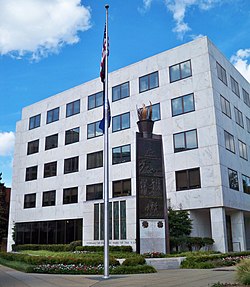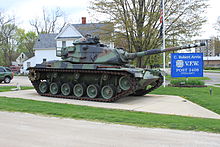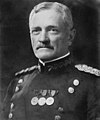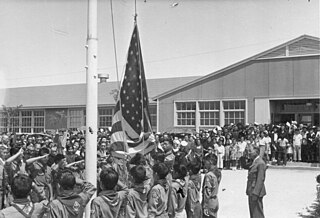
During the early years of World War II, Japanese Americans were forcibly relocated from their homes on the West Coast because military leaders and public opinion combined to fan unproven fears of sabotage. As the war progressed, many of the young Nisei, Japanese immigrants' children who were born with American citizenship, volunteered or were drafted to serve in the United States military. Japanese Americans served in all the branches of the United States Armed Forces, including the United States Merchant Marine. An estimated 33,000 Japanese Americans served in the U.S. military during World War II, of which 20,000 joined the Army. Approximately 800 were killed in action.

Veterans Day is a federal holiday in the United States observed annually on November 11, for honoring military veterans of the United States Armed Forces. It began, and now coincides with other holidays, including Armistice Day and Remembrance Day, which are commemorated in other countries, marking the anniversary of the end of World War I. Major hostilities of World War I were formally ended at the 11th hour of the 11th day of the 11th month of 1918 when the Armistice with Germany went into effect. At the urging of major U.S. veteran organizations, Armistice Day was renamed Veterans Day in 1954.

The American Legion, commonly known as the Legion, is an organization of U.S. war veterans headquartered in Indianapolis, Indiana. It comprises state, U.S. territory, and overseas departments, in turn made up of local posts. It was established in March 1919 in Paris, France, by officers and men of the American Expeditionary Forces (A.E.F.). It was subsequently chartered by the 66th U.S. Congress on September 16, 1919.

Charles Timothy Hagel is an American military veteran and former politician who served as the 24th United States secretary of defense from 2013 to 2015 in the administration of Barack Obama. He previously served as chairman of the president's Intelligence Advisory Board from 2009 to 2013 and as a United States senator representing Nebraska from 1997 to 2009.

The 442nd Infantry Regiment was an infantry regiment of the United States Army. The regiment including the 100th Infantry Battalion is best known as the most decorated in U.S. military history, and as a fighting unit composed almost entirely of second-generation American soldiers of Japanese ancestry (Nisei) who fought in World War II. Beginning in 1944, the regiment fought primarily in the European Theatre, in particular Italy, southern France, and Germany. The 442nd Regimental Combat Team (RCT) was organized on March 23, 1943, in response to the War Department's call for volunteers to form the segregated Japanese American army combat unit. More than 12,000 Nisei volunteers answered the call. Ultimately 2,686 from Hawaii and 1,500 from mainland U.S. internment camps assembled at Camp Shelby, Mississippi in April 1943 for a year of infantry training. Many of the soldiers from the continental U.S. had families in internment camps while they fought abroad. Meaning to risk everything in order to win, the unit's motto was "Go For Broke". Before they left Mississippi, the 100th was given permission to use the slogan it wanted, "Go For Broke," the crapshooters' cry to "shoot the works."

Veterans of Future Wars (VFW) was a satirical political organization initially created as a prank by Princeton University students in 1936. The group was conceived as a parody of the Veterans of Foreign Wars and the movement for early payment of a bonus to veterans of World War I that had been originally scheduled for disbursement in 1945 when the World War Adjusted Compensation Act was passed in 1924. The group jokingly advocated the payment of a similar $1,000 "bonus" to future veterans of a coming European conflagration while the recipients were young enough—and alive—to enjoy it.

American Veterans (AMVETS) is a non-partisan, volunteer-led organization formed by World War II veterans of the United States military. It advocates for its members as well as for causes that its members deem helpful to the nation at large. The group holds a Federal charter under Title 36 of the United States Code. It is a 501(c)19 organization.
A veterans' organization, also known as an ex-service organization, is an organization composed of persons who served in a country's armed forces, especially those who served in the armed forces during a period of war. The organization's concerns include benefits for spouses and children, veterans' claims, post-traumatic stress disorder (PTSD) issues, and other topics related to veterans and to their families.

Everett Alvarez Jr. is a retired United States Navy officer who endured one of the longest periods as a prisoner of war (POW) in U.S. military history. Alvarez was the first U.S. pilot to be shot down and detained during the Vietnam War and spent over eight years in captivity, making him the second longest-held U.S. POW, after U.S. Army Colonel Floyd James Thompson.

The Go for Broke Monument in Little Tokyo, Los Angeles, California, commemorates Japanese Americans who served in the United States Army during World War II. It was created by Los Angeles architect Roger M. Yanagita whose winning design was selected over 138 other submissions from around the world.

Ruppert Leon Sargent was a United States Army officer and a recipient of America's highest military decoration—the Medal of Honor—for his actions in the Vietnam War.

The Military Intelligence Service was a World War II U.S. military unit consisting of two branches, the Japanese American unit and the German-Austrian unit based at Camp Ritchie, best known as the "Ritchie Boys". The unit described here was primarily composed of Nisei who were trained as linguists. Graduates of the MIS language school (MISLS) were attached to other military units to provide translation, interpretation, and interrogation services.

The Post-9/11 Veterans Educational Assistance Act of 2008 is Title V of the Supplemental Appropriations Act of 2008, Pub. L.Tooltip Act of Congress#Public law, private law, designation 110–252 (text)(PDF), H.R. 2642, an Act of Congress which became law on June 30, 2008. The act amended Part III of Title 38, United States Code to include a new Chapter 33, which expands the educational benefits for military veterans who have served since September 11, 2001. At various times the new education benefits have been referred to as the Post-9/11 GI Bill, the 21st Century G.I. Bill of Rights, or the Webb G.I. Bill, with many current references calling it simply the new G.I. Bill. President George W. Bush signed H.R. 2642 into law on June 30, 2008.

Jewish War Veterans of the United States of America is an American Jewish veterans' organization created in 1896 by American Civil War veterans to raise awareness of contributions made by Jewish service members.
Robert Nimmo was an American military officer and politician who served as the Administrator of Veterans Affairs from 1981 to 1983. He previously served in both chambers of the California State Legislature.
The United States military formerly excluded gay men, bisexuals, and lesbians from service. In 1993, the United States Congress passed, and President Bill Clinton signed, a law instituting the policy commonly referred to as "Don't ask, don't tell" (DADT), which allowed gay, lesbian, and bisexual people to serve as long as they did not reveal their sexual orientation. Although there were isolated instances in which service personnel were met with limited success through lawsuits, efforts to end the ban on openly gay, lesbian, and bisexual people serving either legislatively or through the courts initially proved unsuccessful.
A veterans' court is a "special court" which is charged with trying cases of minor offenses which involve veterans, particularly those diagnosed with service-related illnesses. The first veterans' court was established in 2008 in Buffalo, New York, and has been used as a model for establishments of other veterans' courts in other parts of the United States. There are questions, however, about the judicial system allowing a "special class." Although the court only deals with misdemeanors, the prosecutors and judges can choose to allow defendants to agree to plead guilty to a misdemeanor, thus reducing the charges.
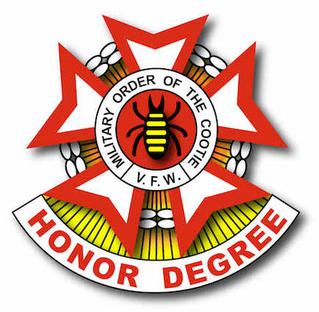
The Military Order of the Cootie of the United States is a national honor degree membership association separately constituted as a subordinate and as an auxiliary order chartered by the Veterans of Foreign Wars of the United States (VFW). The organization's services include supporting the VFW National Home and veterans hospitals. Founded in 1920, it became a subsidiary of the VFW in 1923.

Charles Paul Wilson II is a retired United States Air Force colonel who is notable for his work in political-military affairs, national security policy, defense acquisition, and business development. He commanded four different military units at the squadron and wing organizational levels. Wilson performed operational testing of the prototype S1034 pressure suit and flew the first operational mission of the Lockheed U-2S spy plane. He is a rated US Air Force command pilot with over 3,800 flight hours.

Nisei Memorial VFW Post 8985 was founded in 1947 by Japanese-American World War II veterans of the 442nd RCT and the Military Intelligence Service in Sacramento, California. Its members would form the first of 14 segregated Nisei VFW posts chartered in California. The post's clubhouse, originally built as a restaurant, was purchased with assistance from the local JACL in 1955, and is now the last remaining property associated with what was once Sacramento's historic Japantown.

